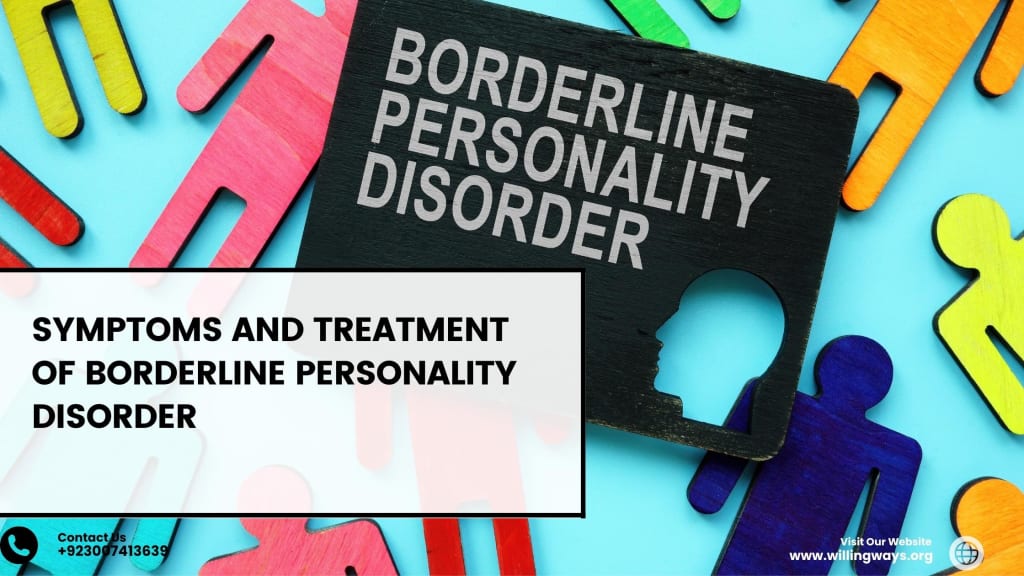Symptoms and Treatment of Borderline Personality Disorder
Disorder (BPD) is the long-term pattern of the best addiction treatment center in Karachi and the behavior marked by extremes of emotion, volatile and, at times, impulsivity, and a wide range of problematic, turbulent, and unstable emotions.

Disorder (BPD) is the long-term pattern of the best addiction treatment center in Karachi and the behavior marked by extremes of emotion, volatile and, at times, impulsivity, and a wide range of problematic, turbulent, and unstable emotions. Colloquially, borderline personality disorder symptoms might be called emotional instability. But that is hardly sufficient because the disorder is characterized by a conglomeration of several symptoms, with unusually dramatic ranges of response, depths of emotions, rapid changes between depression and elation, idealization and devaluation of self and others, deep feelings of abandonment, and significantly, feelings of entitlement (narcissism). The word "borderline" refers to people knowing How Does the Linden Method Work For Anxiety-Free Life to the state between neurosis and psychosis.
Borderline Personality Disorder Symptoms
Such variability of feelings affects behavior, which naturally reflects on interpersonal relationships. Whereas stable relationships are characterized by consistent and predictable behavior that is logical and linear, unstable relationships are marked by chaos. At any given moment, what seemed like a rational conversation or behavior suddenly made no sense. Mental health disorder-related patients wanted to know how to control alcohol cravings. The sufferer was sullen or verbally abusive without any apparent reason to have incited such a turnaround. When that happens, those closest to the sufferer may feel puzzled or angry and, like the proverbial cartoon, dazedly scratching their head, muttering, "What the heck just happened?"
Narcissism is a term coined from the Greek legend of Narcissus, who gazed at himself in a pond and fell in love with his image. Applying this term to BPD means the sufferer rarely recognizes their role in dysfunctional situations. The instability in borderline personality disorders creates great confusion among the people closest to the sufferer. The sufferer's inconsistent and unpredictable responses stir trouble of all kinds in his or her environment. In the mind of the sufferer, however, because of the selfish feelings involved, the troubled relationships and confused scenarios are always the results of outside people or situations, and thus the sufferer feels victimized. Ironically, one of the characteristics of this illness is a deep, irrational fear of abandonment, which is precisely what happens because of the erratic behavior of the sufferer. The sufferer then makes frantic efforts to justify the situation, absolving him- or herself of guilt by accusing others of having fabricated the case.
The range of difficulties caused by BPD is vast, from family intrigues, surreptitiousness, conspiracies, and impulsive, expansive behaviors, all to either bolster the sufferer's inflated self-esteem or support their imagined feelings of having been grossly and unjustly maligned. The sufferer typically has a distorted self-image, at times self-aggrandizing, at other times self-deprecating. This alternation between positive regard and deep disappointment characterizes borderline personality disorder symptoms. In close relationships, as with mothers and their children, withdrawal from the situation is frequently difficult, if not impossible, and the ties endure unabated. In many cases, the children will assume guilt feelings themselves because of the strong influence the disturbed parent had during the child's earliest formative years.
Possible Treatments
It might seem that borderline personality disorder treatment would come in psychotherapy and medications, such as mood stabilizers and antipsychotics. Various styles of psychotherapy might be useful, including cognitive therapy or dialectical therapy (cognitive-behavioral therapy). Sadly, that is frequently not the case. The problem with borderline personality disorder treatment is that the sufferer, being narcissistic, believes that others cause all his or her problems and that, in fact, he or she has no problem at all. The sufferer feels justified in his or her feelings rather than recognize that his or her behavior is dysfunctional. It rarely occurs to the sufferer that he or she may have instigated a situation that is incompatible with his or her sense of or her self-aggrandized vision. The such dilemma is what makes borderline personality disorder treatment so complicated and frequently unsuccessful.
A borderline personality disorder is an extremely complex disorder characterized by maladaptive behaviors that morph into psychosis, suffered by a narcissist. Thus, borderline personality disorder treatment is a challenge that has yet to get a foothold in the psychotherapeutic community.
About the Creator
Willing Ways
Willing Ways is the Best addiction treatment center in Pakistan. We are the pioneer in drugs & alcohol treatment centers with outstanding services and a history of 43 years. We deliver quality writing that is beneficial for you.






Comments
There are no comments for this story
Be the first to respond and start the conversation.